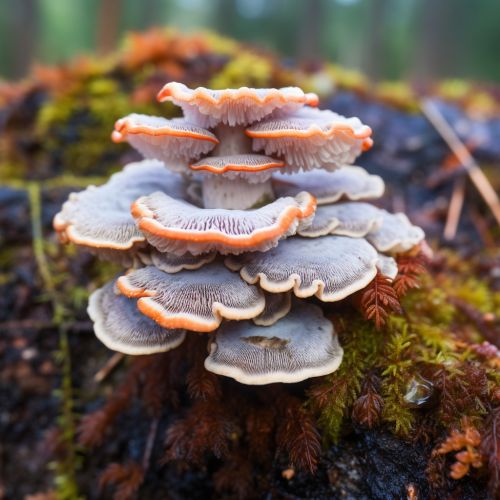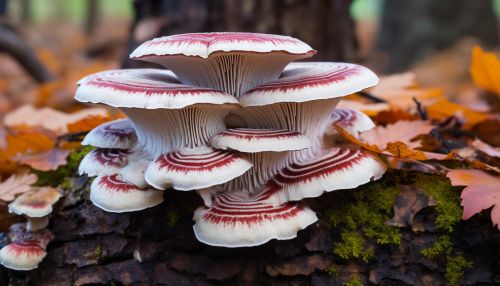Trametes versicolor
Taxonomy and Naming
The Trametes versicolor, commonly known as the Turkey Tail, is a polypore mushroom that belongs to the family Polyporaceae. The species was first described scientifically by Carl Linnaeus in 1753, who initially named it Boletus versicolor. The mushroom's current scientific name, Trametes versicolor, was given by the French mycologist Lucien Quélet in 1886. The genus name Trametes is derived from the Latin word "trames", meaning "crossing" or "passage", while the species name versicolor refers to the changeable colors of the mushroom's cap.


Description
Trametes versicolor is a highly variable mushroom, with caps that can range in color from white to dark brown, often displaying multiple colors at once in concentric zones. The cap surface is velvety to touch, and the edges are typically wavy or lobed. The underside of the cap features tiny pores, through which the mushroom releases its spores. The pores are white to light yellow in color and do not change color when bruised. The mushroom's flesh is white, tough, and fibrous.
Distribution and Habitat
Trametes versicolor is a cosmopolitan species, found in forests throughout the world. It is particularly common in North America, Europe, and Asia. The mushroom grows primarily on dead hardwoods, although it can occasionally be found on conifer wood. It is a saprobic fungus, meaning it obtains its nutrients by decomposing dead or decaying organic material. Because of this, Trametes versicolor plays a crucial role in nutrient cycling in forest ecosystems.
Growth and Development
The life cycle of Trametes versicolor follows the typical basidiomycete pattern. The mushroom produces microscopic spores that are released into the environment. When these spores land on a suitable substrate, they germinate and form a network of hyphae, known as a mycelium. The mycelium grows and eventually forms a new mushroom. Trametes versicolor typically produces new fruiting bodies annually, and the mushrooms can often be found growing in large clusters.
Ecological Role
As a saprobic fungus, Trametes versicolor plays a vital role in decomposing dead wood and recycling nutrients in forest ecosystems. The mushroom's enzymes can break down lignin, a complex organic polymer that gives wood its strength. This ability to decompose lignin makes Trametes versicolor one of the few organisms capable of breaking down this tough material. By doing so, the mushroom helps to speed up the decomposition process and return nutrients to the soil.
Uses
Trametes versicolor has a long history of use in traditional medicine, particularly in Asia. The mushroom is used in the form of a tea or extract in traditional Chinese medicine, where it is known as Yun Zhi. In Japan, it is known as Kawaratake and is used in a similar manner. The mushroom is believed to have immunomodulatory properties and has been studied for its potential use in cancer treatment.
Research and Potential Health Benefits
Several compounds isolated from Trametes versicolor, including polysaccharide-K (PSK) and polysaccharide-peptide (PSP), have been studied for their potential health benefits. PSK and PSP are believed to have immunomodulatory effects and have been used as adjuvants in cancer therapy in Japan and China. Some studies suggest that these compounds may improve survival rates and quality of life in cancer patients, although more research is needed to confirm these findings.
